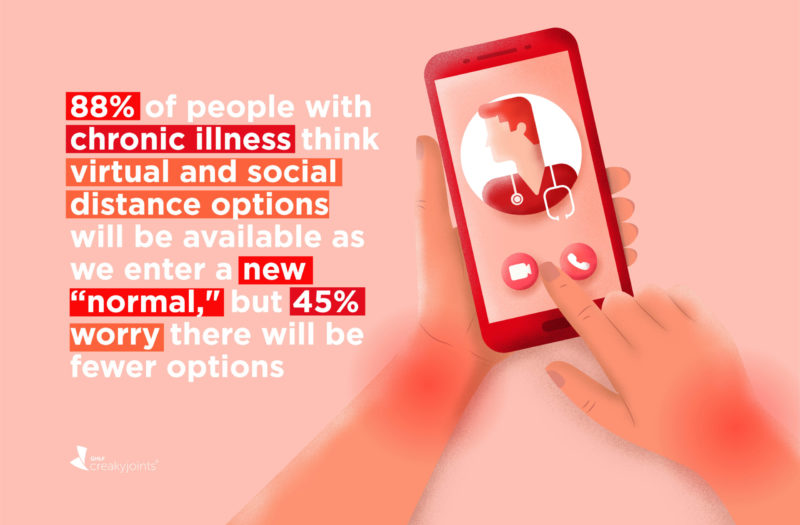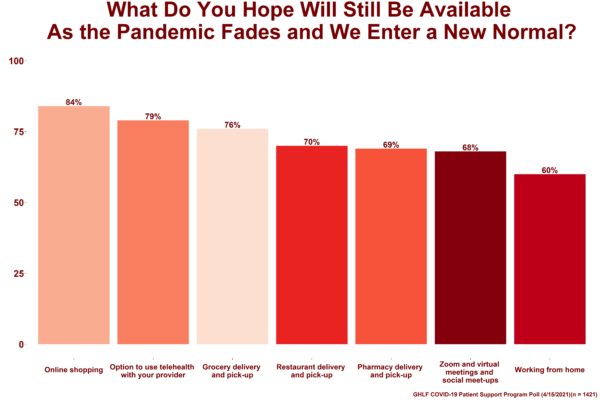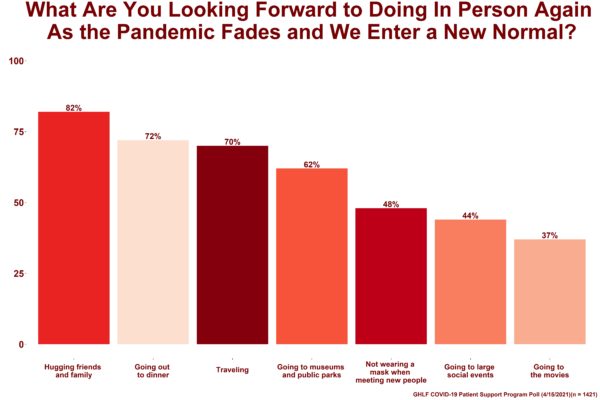Learn more about our FREE COVID-19 Patient Support Program for chronic illness patients and their loved ones.
As of April 21, more than 928 millions COVID-19 vaccines have been issues around the world. The U.S. Centers for Disease Control and Prevention (CDC) recently released new guidance that says fully vaccinated people can travel. Families are reuniting after more than a year apart. Restaurants are increasing their capacity for indoor dining available. It seems as though things are slowly returning to “normal.”
This is promising news, but it also raises a lot of issues for the chronic illness community. Not just because of ongoing concerns of safety and COVID-19 risk for those who are immunocompromised, but also because people with chronic illnesses have benefitted in many ways from precautions that were implemented during the COVID-19 pandemic. Mask mandates and grocery deliveries helped limit exposure to infections, which is crucial for people who are immunocompromised. Zoom weddings and work meetings provided flexibility for people with chronic diseases, who often have to miss events if they’re having disease flares or if travel is just too onerous for their health.
That’s not to say the pandemic has been easy on people with chronic illnesses, of course. Telehealth, while convenient, does not always provide the same quality care for people with rheumatic or other chronic diseases. Additionally, there has been limited research on how COVID-19 affects people with inflammatory and autoimmune diseases, and limited data on the vaccine’s effectiveness in people who take immunosuppressant medications.
It’s unclear what the future holds, so it’s no wonder that many people with chronic illness are both hopeful and concerned about whether a post-pandemic “normal” will continue to encompass the elements of pandemic life that actually accommodate this community, rather than make people feel marginalized or left behind.
A recent poll of 1,421 people, conducted by the Global Healthy Living Foundation (GHLF) as part of its COVID-19 Patient Support Program, aimed to gain insight into what people with chronic illness want a post-pandemic “normal” to look like — and whether it will be accommodating to their needs. The poll, which was conducted between April 15-18, 2021, asked patients if they think virtual options will still be available to them as the world enters a new “normal.”
Of those who responded, 1,245 patients — 88 percent — said they think events and socially distant services will still be available. At the same time, 45 percent of respondents worry that fewer virtual options will be available as the pandemic evolves.
When given the option to fill in the free-response section of the poll, many people expressed hope for the future, but expressed a desire to proceed with caution.
- “I feel that everything that is currently in place should stay in place and we shouldn’t become complacent,” one person wrote. “Virtual [options] shouldn’t be only during a pandemic; it needs to be available always.”
- “Virtual is an enhancement for most but wonderful for the homebound,” another person said.
- Similarly, one patient wrote that they were, “glad we discovered a lot of things can be done virtually” and “hopes this continues as it is very convenient for those of us who have chronic illnesses.”
For the 166 patients — 12 percent — who don’t think virtual options will be as readily available, fears and concerns stem from being left behind in the pre-pandemic world.
- “I am scared that I will be left behind because of my immune system,” one patient shared.
- “I am in a wheelchair and it can be hard to participate in activities that are not accessible,” one person shared. “I feel like the playing field was leveled when nobody could do things that I cannot typically do. As people are able to do these things in person again, I know I will feel left behind again.”
Here are some more insights into what people with chronic illness want a post-pandemic “normal” to look like.
Telehealth, grocery delivery, and working from home are “new normal” priorities for people with chronic illnesses
“I look forward to more in-person outings. That said, from a chronic illness perspective, curbside pick-up and telehealth have been very helpful,” one person wrote. Many other poll respondents were in agreement. When people were asked to choose which virtual and social distance options they would like to see in a post-pandemic world, here is how they responded. (They could select all that apply.)
- 84% said online shopping
- 79% said option to use telehealth with your provider
- 76% said grocery delivery and pick-up
- 70% said restaurant delivery and pick-up
- 69% said pharmacy delivery and pick-up
- 68% said Zoom and virtual meetings and social meetups
- 60% said working from home
Online shopping, grocery delivery, and grocery pick-up were available prior to the pandemic, but utilization has grown significantly over the past year. According to a November 2020 report from eMarketer and Business Insider Intelligence, online grocery sales in the U.S. increased by 53 percent in 2020. A survey conducted by the United Nations Conference on Trade and Development yielded similar results. The survey, which polled people across Brazil, China, Germany, Italy, the Republic of Korea, Russian Federation, South Africa, Switzerland and Turkey, found that 52 percent of participants shop online more frequently now than they did pre-pandemic.
Telehealth, while not as readily available pre-pandemic, became the norm after the U.S. Centers for Disease Control and Prevention (CDC) asked non-emergency medical care providers to prioritize telehealth consultations.
Many people praised telehealth in the free response section of the poll.
“I drive 90 minutes to see a rheumatologist,” one person wrote, citing that the drive is especially difficult in the winter. “It makes such a difference to have [telehealth] as a backup.”
That said, some patients feel, “virtual or telehealth visits should supplement, not replace, in person appointments,” as one person wrote in the free response section.
“I found telehealth meetings very unsatisfactory for my condition, especially phone calls,” one person shared. “They were rushed and I had trouble hearing/understanding the doctor on the phone.”
Another patient echoed this thought, adding that “there is a lot lost in content over a [virtual] appointment.”
People with chronic illness are most excited to hug loved ones in a post-pandemic world
Poll respondents were asked what they were looking forward to doing in person. The most popular selection among participants — 82 percent — was hugging family and friends.
“I will be able to hug my grandchildren,” one person wrote. “That alone is therapeutic.”
People were also looking forward to go out to dinner (72 percent), travel (70 percent), and go to museums and parks (62 percent.) Fewer people, however, said they were looking forward to being around large groups of people, particularly indoors. Only 44 percent said they were excited to go to large social events, such as concerts and sporting events. Even fewer (37 percent) wanted to go to the movies.
“Large crowds may always be a concern for me, but my hope is that ‘herd immunity’ will make life a bit easier,” one patient said.
“I don’t miss going to movies, or large crowded events,” another person said. “I do miss seeing my family, especially one in the nursing home.”
“I will always be concerned about being in a crowd, such as a concert or wedding,” one patient wrote, with another adding they would “avoid indoor events.”
Masks may become the norm in a post-pandemic world
When asked if they were looking forward to not wearing a mask when meeting new people, only 48 percent of patients said yes. In the free response section, some people expressed that masks would continue to be important as they adapt to their new normal. Of course, many people in the chronic illness community have been wearing masks long before the pandemic, especially during cold and flu season.
“As someone who is immune suppressed already and (hopefully) awaiting a kidney transplant, I expect to be wearing a mask in public from now on,” one person shared, adding, “as long as I can see my kids and some friends I am good.”
“I have really come to value wearing a mask as something that keeps me safe,” one respondent said. “I would rather look stupid or alarmist than be sick.”
The Global Healthy Living Foundation is committed to providing ongoing education about staying safe during COVID-19 for the chronic illness and immunocompromised community. To stay informed, follow all of our tips for daily living during COVID-19 when you have a chronic illness.
Get Free Coronavirus Support for Chronic Illness Patients
Join the Global Healthy Living Foundation’s free COVID-19 Support Program for chronic illness patients and their families. We will be providing updated information, community support, and other resources tailored specifically to your health and safety.
About the Patient Support Program Quick Poll
Members of our program have underlying health issues — such as inflammatory arthritis and other autoimmune conditions, heart disease, lung disease, diabetes, and more — that may increase their risk for COVID-19 complications. They are interested in understanding the best ways to stay safe during the pandemic and to be part of a community of people with similar concerns, questions, and fears.
We regularly poll members, who live in the U.S. as well as around the globe, about a variety of topics, including how the pandemic is affecting their lifestyle, mental health, chronic disease management, medication adherence, and more.
We use this information to inform the educational resources we provide and to inform other stakeholders — such as public health experts, policymakers, advocacy groups, health care professionals, and pharmaceutical companies — about chronic illness patients’ needs and concerns. You can participate in ongoing polls by joining the support program here.
COVID-19 has changed online shopping forever, survey shows. United Nations Conference on Trade and Development. October 8, 2020. https://unctad.org/news/covid-19-has-changed-online-shopping-forever-survey-shows.
Healthcare Facilities: Managing Operations During the COVID-19 Pandemic. Centers for Disease Control and Prevention. March 17, 2021. https://www.cdc.gov/coronavirus/2019-ncov/hcp/guidance-hcf.html.
Holder, J. Tracking Coronavirus Vaccinations Around the World. The New York Times. April 21, 2021. https://www.nytimes.com/interactive/2021/world/covid-vaccinations-tracker.html.
Interim Public Health Recommendations for Fully Vaccinated People. COVID-19. U.S. Centers for Disease Control and Prevention. April 2, 2021. https://www.cdc.gov/coronavirus/2019-ncov/vaccines/fully-vaccinated-guidance.html.
Rimma K. Online grocery sales will increase by nearly 53% this year. EMarketer. November 17, 2021. https://www.emarketer.com/content/online-grocery-sales-will-increase-by-nearly-53-this-year.








